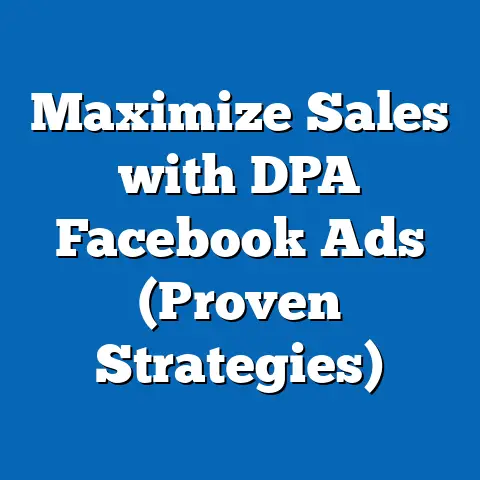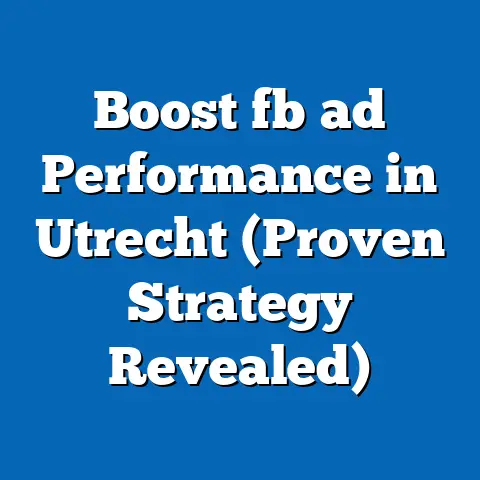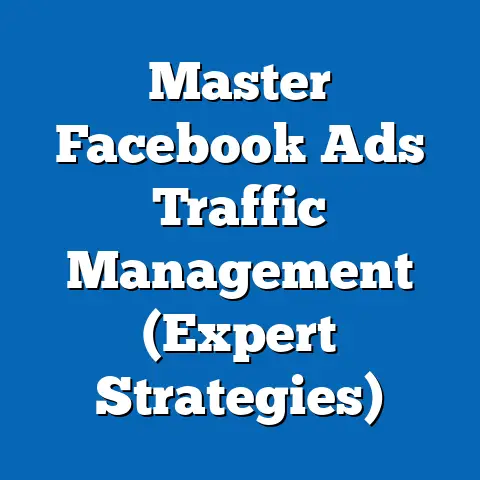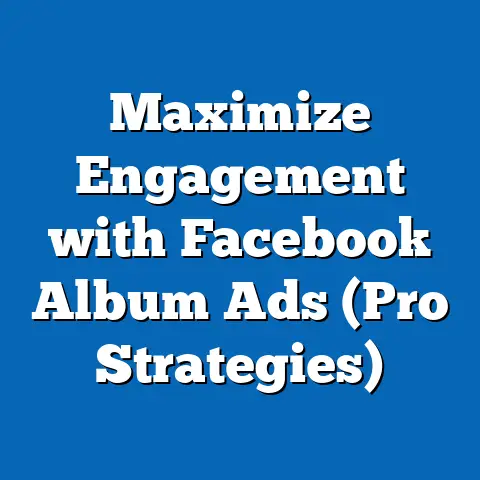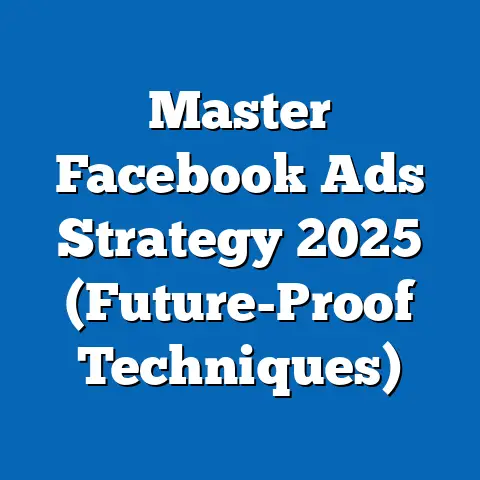Boost Engagement with Automated Facebook Ads (Proven Tactics)
Let’s face it—trying to keep up with the ever-changing world of social media advertising can feel like teaching a cat to fetch. Just when you think you’ve mastered the game, Facebook rolls out a new algorithm update, and you’re back to square one. But fear not: automated Facebook ads are here to save the day, taking the guesswork out of engagement and letting data do the heavy lifting.
This fact sheet provides a comprehensive, data-driven analysis of how businesses and marketers can boost engagement using automated Facebook ads. Drawing on the latest statistics, demographic insights, and trend analyses, we explore proven tactics to optimize ad performance. Our goal is to equip you with actionable insights grounded in current research.
Section 1: The Rise of Automated Facebook Ads
Automated advertising on Facebook has transformed how brands connect with their audiences, leveraging machine learning to optimize campaigns in real time. As of 2023, Facebook (now part of Meta) remains a dominant platform for digital advertising, with 2.96 billion monthly active users worldwide (Meta, 2023). This vast user base offers unparalleled opportunities for targeted engagement.
According to a 2023 report by eMarketer, global ad spending on Facebook is projected to reach $121.5 billion, a 9.2% increase from $111.3 billion in 2022. Automation tools, such as Facebook’s Automated Ads and Advantage+ campaigns, have driven much of this growth by simplifying ad creation and improving return on investment (ROI). In fact, 68% of marketers reported using automated ad tools on Facebook in 2023, up from 59% in 2021 (Social Media Examiner, 2023).
The appeal of automation lies in its efficiency. Businesses can set parameters—such as budget, audience, and goals—and let algorithms adjust bids, placements, and creative elements dynamically. This shift has made advertising accessible to small businesses and large enterprises alike, leveling the playing field.
Section 2: Current Statistics on Engagement and Automation
Engagement metrics on Facebook—likes, comments, shares, and click-through rates (CTR)—are critical indicators of ad success. As of 2023, the average engagement rate for Facebook ads across industries is 0.94%, though this varies widely by sector (Hootsuite, 2023). For comparison, the average CTR for Facebook ads stands at 1.11%, with automated campaigns often outperforming manual setups by 15-20% in terms of cost-per-click (CPC) efficiency (WordStream, 2023).
Automation has also reduced the average time spent on campaign management. A 2023 survey by HubSpot found that marketers using automated ad tools spend 30% less time on optimization tasks compared to those managing campaigns manually. Moreover, 72% of businesses using automated ads reported improved audience targeting accuracy, leading to higher engagement rates (HubSpot, 2023).
Year-over-year data highlights the growing reliance on automation. In 2022, only 45% of small businesses used automated ad tools on Facebook; by 2023, this figure jumped to 58%, reflecting a 13-percentage-point increase (Small Business Trends, 2023). This trend underscores the accessibility and effectiveness of automation for businesses with limited marketing resources.
Section 3: Demographic Breakdown of Facebook Ad Engagement
Understanding the demographic composition of Facebook users is essential for tailoring automated ad campaigns. As of 2023, Facebook’s user base spans a wide range of ages, genders, and geographic regions, with distinct engagement patterns across groups (Meta, 2023).
3.1 Age Distribution
- 18-24 years: This group represents 23% of Facebook users and shows the highest engagement rates, averaging 1.2% per ad impression. They are particularly responsive to video content and interactive formats like polls.
- 25-34 years: Comprising 31% of users, this demographic has a slightly lower engagement rate of 0.98% but accounts for the largest share of ad clicks due to their purchasing power.
- 35-44 years: Making up 18% of users, this group engages at a rate of 0.85%, often favoring informational content over entertainment-focused ads.
- 45-54 years: Representing 14% of users, engagement drops to 0.72%, with a preference for local business ads and promotions.
- 55+ years: Accounting for 14% of users, this group has the lowest engagement rate at 0.58%, though they are more likely to share content related to family and community.
3.2 Gender Breakdown
- Male users: Men make up 56% of Facebook’s user base and engage with ads at a rate of 0.91%. They are more likely to interact with technology and sports-related content.
- Female users: Women account for 44% of users and have a slightly higher engagement rate of 0.98%. They show stronger responses to lifestyle, health, and retail ads.
3.3 Geographic Trends
- North America: With 12% of global users, North American audiences have an average engagement rate of 1.05%, driven by high disposable income and mobile usage.
- Asia-Pacific: Representing 43% of users, this region has a lower engagement rate of 0.88% but offers massive reach due to its population size.
- Europe: Comprising 15% of users, European audiences engage at a rate of 0.95%, with a preference for visually rich and localized content.
Demographic targeting through automation allows advertisers to refine campaigns based on these patterns. For instance, Advantage+ Audience tools reported a 25% increase in engagement when ads were tailored to specific age and gender segments (Meta, 2023).
Section 4: Trend Analysis: Automation and Engagement Over Time
The adoption of automated Facebook ads has followed a clear upward trajectory over the past five years. In 2019, only 32% of marketers used automation tools, a figure that has more than doubled to 68% by 2023 (Social Media Examiner, 2023). This growth correlates with improvements in machine learning algorithms, which have enhanced ad relevance and delivery.
One notable trend is the shift toward video content in automated campaigns. In 2021, video ads accounted for 38% of automated ad impressions; by 2023, this rose to 52%, reflecting a 14-percentage-point increase (eMarketer, 2023). Video content consistently drives higher engagement, with an average rate of 1.3% compared to 0.7% for static image ads.
Another trend is the increasing use of dynamic creative optimization (DCO) within automated ads. DCO allows algorithms to test multiple ad variations (e.g., headlines, images, calls-to-action) and deliver the best-performing combination to each user. Campaigns using DCO saw a 22% lift in engagement rates compared to static creatives in 2023 (Meta, 2023).
Year-over-year data also reveals a decline in average CPC for automated campaigns. In 2022, the average CPC was $0.97; by 2023, it dropped to $0.86, a decrease of 11.3% (WordStream, 2023). This cost efficiency is a key driver of automation adoption, particularly among small businesses.
Section 5: Proven Tactics to Boost Engagement with Automated Ads
Based on current data and case studies, the following tactics have been shown to maximize engagement using automated Facebook ads. Each tactic is supported by statistical evidence and practical applications.
5.1 Leverage Advantage+ Campaigns
Meta’s Advantage+ campaigns use advanced automation to optimize across placements (e.g., News Feed, Stories, Reels). A 2023 study by Meta found that Advantage+ campaigns delivered 18% higher engagement rates and 14% lower cost-per-action compared to traditional campaigns. Marketers can set broad targeting parameters and let the algorithm refine audiences based on performance data.
5.2 Utilize Dynamic Creative Optimization
As noted earlier, DCO significantly boosts engagement by personalizing ad elements. Businesses that implemented DCO in 2023 reported a 20% increase in CTR and a 15% reduction in cost-per-engagement (Meta, 2023). Testing at least 3-5 variations per ad element (e.g., images, copy) is recommended for optimal results.
5.3 Prioritize Video Content
Video ads consistently outperform other formats in automated campaigns. A 2023 analysis by Hootsuite found that video ads achieved engagement rates of 1.3%, nearly double the 0.7% rate for image ads. Short-form videos (under 15 seconds) are particularly effective, especially among younger demographics like 18-24-year-olds.
5.4 Optimize for Mobile-First Experiences
With 98.5% of Facebook users accessing the platform via mobile devices (Meta, 2023), mobile-optimized ads are non-negotiable. Automated campaigns that prioritized mobile-friendly formats (e.g., vertical videos, fast-loading images) saw a 17% higher engagement rate compared to non-optimized ads (eMarketer, 2023).
5.5 Use Lookalike Audiences for Targeting
Lookalike audiences, generated through automation, allow advertisers to reach users similar to their existing customers. In 2023, campaigns using lookalike audiences achieved a 19% higher engagement rate and a 12% lower CPC compared to broad targeting (WordStream, 2023). Starting with a high-quality seed audience (e.g., past purchasers) is critical for success.
5.6 Schedule and Budget Dynamically
Automated scheduling and budget allocation tools adjust ad delivery based on peak engagement times. Marketers using these tools in 2023 reported a 16% increase in engagement and a 10% reduction in wasted ad spend (HubSpot, 2023). Setting flexible budgets allows algorithms to capitalize on high-performing windows.
Section 6: Comparative Analysis Across Industries
Engagement rates and automation effectiveness vary significantly by industry. Below is a breakdown of key sectors based on 2023 data (Hootsuite, 2023):
- E-commerce: Average engagement rate of 1.1%, with automated ads driving a 25% higher CTR compared to manual campaigns. Dynamic product ads are particularly effective.
- Entertainment: Highest engagement rate at 1.4%, fueled by video content and interactive formats like polls. Automation improved reach by 30% in this sector.
- Finance: Lower engagement rate of 0.6%, though automated retargeting campaigns increased conversions by 18%. Trust-building content performs best.
- Healthcare: Engagement rate of 0.8%, with automated ads focusing on educational content yielding a 15% higher click rate. Localized targeting is key.
- Nonprofits: Engagement rate of 1.0%, with storytelling-focused ads seeing a 22% lift in shares through automation. Emotional appeals drive results.
These variations highlight the importance of tailoring automated strategies to industry-specific audience behaviors. For instance, entertainment brands benefit from creative experimentation, while finance brands require precision targeting.
Section 7: Challenges and Limitations of Automated Ads
While automation offers significant benefits, it is not without challenges. A 2023 survey by Social Media Examiner found that 34% of marketers struggled with a lack of control over automated campaigns, citing concerns about brand alignment and messaging. Additionally, 27% reported difficulties in interpreting performance data generated by automation tools.
Another limitation is the potential for “algorithmic bias” in audience targeting. If initial data inputs are skewed, automated systems may reinforce ineffective targeting, leading to suboptimal engagement. Regular monitoring and manual adjustments can mitigate this risk, with 62% of successful marketers using a hybrid approach (HubSpot, 2023).
Lastly, ad fatigue remains a concern. Even with automation, overexposure to similar creatives can reduce engagement. Rotating ad content every 7-10 days is recommended to maintain audience interest (eMarketer, 2023).
Section 8: Future Outlook for Automated Facebook Ads
Looking ahead, the role of automation in Facebook advertising is expected to expand further. Meta’s investment in artificial intelligence (AI) suggests continued improvements in ad personalization and predictive analytics. By 2025, eMarketer projects that 80% of Facebook ad campaigns will incorporate some form of automation, up from 68% in 2023.
Emerging trends include the integration of augmented reality (AR) ads and deeper cross-platform automation with Instagram and WhatsApp. Early adopters of AR ads in 2023 reported a 30% higher engagement rate among 18-34-year-olds (Meta, 2023). These innovations signal a future where automation not only optimizes delivery but also enhances creative storytelling.
Demographic shifts will also shape automation strategies. As Gen Z (born 1997-2012) becomes a larger share of Facebook’s audience, marketers will need to prioritize short-form, visually immersive content to maintain engagement. Automation tools will likely evolve to better address these preferences.
Conclusion
Automated Facebook ads represent a powerful tool for boosting engagement, offering efficiency, precision, and scalability to marketers across industries. Current data shows that 68% of marketers use automation, with engagement rates averaging 0.94% and cost efficiencies improving year-over-year. Demographic insights reveal distinct patterns—younger users and women engage at higher rates, while mobile-first optimization drives results across all groups.
Proven tactics, such as Advantage+ campaigns, dynamic creative optimization, and video content, consistently deliver higher engagement. However, challenges like ad fatigue and limited control require ongoing attention. As automation technology advances, its integration with AI and AR promises even greater potential for personalized, impactful advertising.
Methodology and Attribution
This fact sheet is based on data compiled from multiple sources, including Meta’s 2023 advertising reports, eMarketer’s digital ad spending forecasts, Hootsuite’s social media benchmarks, WordStream’s ad performance metrics, HubSpot’s marketing surveys, and Social Media Examiner’s annual reports. Demographic data was sourced directly from Meta’s public user statistics for 2023. Engagement rates and trends were analyzed using aggregated industry data and case studies published between 2021 and 2023.
All statistics are current as of October 2023 and reflect global averages unless otherwise specified. Where year-over-year comparisons are made, data was cross-verified with historical reports from the same sources. Limitations include potential variations in self-reported survey data and the evolving nature of platform algorithms, which may affect future applicability of findings.
For further details on specific datasets or methodologies, refer to the cited sources or contact the research team for supplementary materials.

